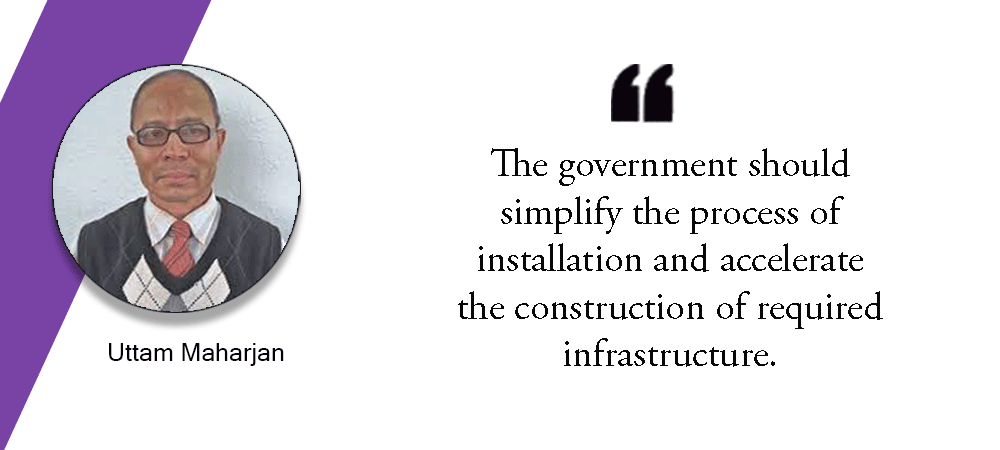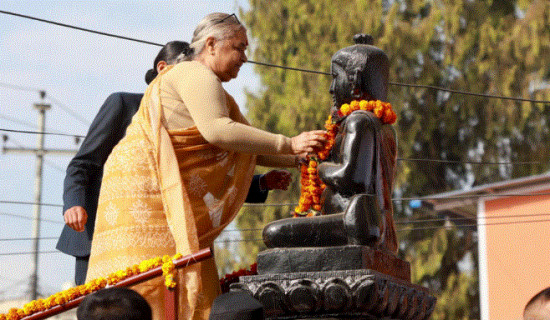- Wednesday, 22 October 2025
The Go-ahead For Embossed Number
The government has recently decided to go ahead with installation of embossed number plates on vehicles as per the current process. The installation of embossed number plates on vehicles has not been made mandatory with the controversy over the script and numbers. The current practice is to use the English script and numbers instead of the Nepali ones. The government is dead-set on implementing the embossed number plate system at any cost. Accordingly, transport management offices have instructed all government offices to install embossed number plates on their vehicles. The government hopes that by Falgun-end, 300,000 two-wheelers and 100,000 four-wheelers will have been fitted with embossed number plates.
The provision for installation of embossed number plates on vehicles is made in Annexure 2 of the Transport Management Act, 2049. The government is planning to make it mandatory for public and private vehicles to be fitted with embossed number plates after Falgun. The government tried to make it compulsory for vehicles to be fitted with embossed number plates from Shrawan 2079 by publishing a notice in Asadh. But the government had to backtrack from its decision amid fierce opposition. The government constituted a task force to study the feasibility of changing the script and design amid growing public demand for changing the same. The task force submitted the report with alternatives of using the Nepali script to the government.
Public demand
The government sought suggestions, as per the public demand for changing the script and design, from the contractor, Tiger Decatur IT, on changing the script into Nepali and improving the design. The contractor said that it was possible but it would entail an additional 50,000 US dollars. The government also sought an opinion on the matter from the Ministry of Law but the ministry did not give any clear opinion. As the number of vehicles fitted with embossed number plates has exceeded 50,000 and changing the script and design will entail a huge cost, the government decided to go ahead with the embossed number plate system without changing the script and design.
The government entered into a contract with Tiger Decatur IT, a Bangladeshi company, for the installation of embossed number plates on 2.5 million vehicles at a cost of US$ 38.75 million in 2072. The process of installing embossed number plates on vehicles began in Bhadra 2074 BS. However, there was a dispute over the script and the names of states. The embossed number plates had zone names. As the provision of states was about to be implemented by revoking zones, province 3 (now Bagmati Province) was inscribed on embossed number plates.
In the meantime, the Supreme Court was moved against the non-use of the Nepali script and numbers. Former Chief Justice Gopal Parajuli’s single bench issued an interim stay order in Falgun 2074 BS, grinding the distribution of embossed number plates to a halt. The writ was, however, revoked by the constitutional bench of now suspended Cholendra SJB Rana and four judges in Mangsir 2076 BS. This paved the way for the government to resume the distribution of embossed number plates from Shrawan 2077 BS. In Bhadra 2077 BS, the Oli-government halted the distribution of embossed number plates over the English script and numbers.
The implementation of the embossed number plate system has gone through controversy after controversy. In the first place, the contractor is one of the companies blacklisted by the World Bank. The payment clause in the contract states, inter alia, that even if the government fails to have 2.5 million vehicles installed with embossed number plates, 95 per cent of the cost shall have to be paid to the contractor as compensation. The contract was renewed in Asar 2078 BS for another 28 months. Sixteen months have elapsed since the renewal of the contract. That is why the government has decided to go ahead with the current embossed number plate system.
There are several factors responsible for the process of installation of embossed number plates on vehicles going at a snail’s pace. People are complaining that the installation cost is too high. The cost is Rs. 2,500 for two-wheelers, Rs. 2,900 for three-wheelers, Rs. 3,200 for four-wheelers and medium vehicles and Rs. 3,600 for big vehicles. People are also not satisfied with the quality of embossed number plates. The number plates are prone to damage, breakage or twisting. Use of the English script and numbers is not digestible to people, either. Moreover, no infrastructure has been in place till now. However, the government says the construction of IRFT gates and other infrastructure will begin soon.
Why people are reluctant to use the embossed number plate system should be analysed by the government. The bureaucratic rule that all taxes of the current fiscal year should be cleared could be a deterrent to people not willing to go for the embossed number plate system. A person who has to pay tax in, say, Falgun as per the bill book may not be willing to pay it right now. The government should not make tax clearance a sine qua non for the installation of embossed number plates on vehicles. Most people are paying tax in time. This will enable people to install embossed number plates on their vehicles at their convenience. They will not have to wait till tax payment time.
New modality
The government has designated places for the installation of embossed number plates on vehicles. This is time consuming. It is a good thing that the government is considering changing the modality of fitting embossed number plates on vehicles. As per the new modality to be adopted, people can collect embossed number plates from transport offices and get them installed on their vehicles by mechanics at workshops.
The embossed number plate system is a scientific system of managing the digital recording of vehicles. The system is in vogue even in India. It has several benefits. It provides safety and security for vehicles. Vehicles can be easily tracked by the in-built GPS. So theft and misuse can be prevented and government revenue can be monitored. But the implementation of the system has been mired in controversy and confusion. The government should simplify the process of installation and accelerate the construction of required infrastructure. There is no question of the embossed number plate system not amenable to implementation.
(Maharjan has been regularly writing on contemporary issues for this daily since 2000. uttam.maharjan1964@gmail.com)

















